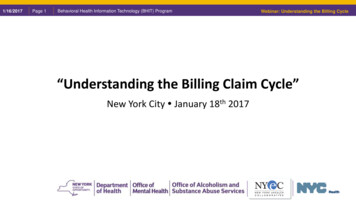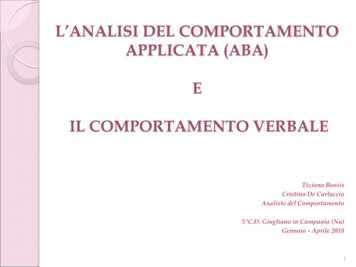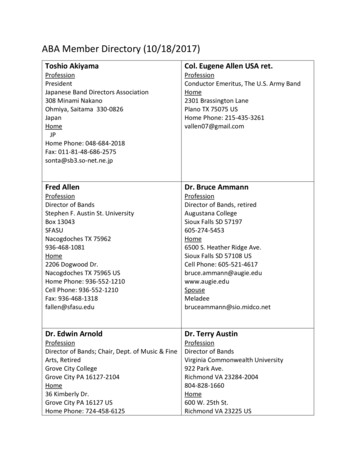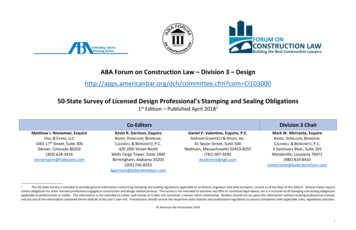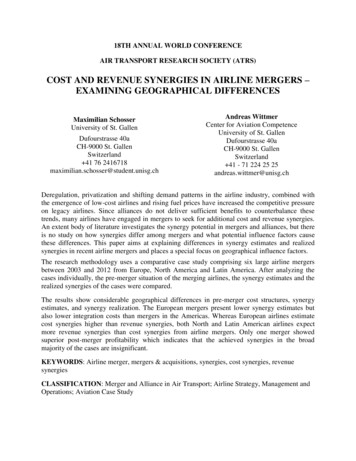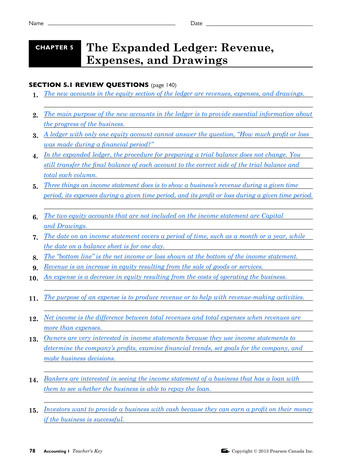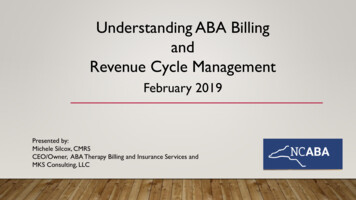
Transcription
Understanding ABA BillingandRevenue Cycle ManagementFebruary 2019Presented by:Michele Silcox, CMRSCEO/Owner, ABA Therapy Billing and Insurance Services andMKS Consulting, LLC
WHAT IS REVENUE CYCLE MANAGEMENT? Revenue Cycle Management (RCM) is the process to set yourself up for success in being reimbursed forservices performed through various funding sources. It is the full cycle from credentialing and contractingwith funding sources, to patient intake, to reimbursement of claims and recording in accounting software. For healthcare insurance funders, it includes the proper steps to complete prior to generating claims toensure the highest level of compliance for reimbursement. The revenue cycle consists of payer policies andguidelines, claims submission, denials and appeals and the tracking of each aspect of the cycle. The financial aspect of the revenue cycle can determine your risks and strengths in remaining solvent in yourpractice as well as your success in passing audits. Maintaining ethical billing standards and compliance are keyto contributing to the best practices of client/patient care, combating fraud, waste and abuse according toCMS standards.
Establish efficientprocesses and criticalchecks and balances foreach key area of theRevenue Cycle.Credentialing andContractingAudit PreparationPatient Intake ProcessA/R Tracking andReportingEligibility and BenefitCheckDenials and AppealManagementReferral andAuthorizationPatient BillingAssessment ProcessPayment Posting andReviewTimekeeping andDocumentationCoding and ClaimsSubmission
CATEGORY I CPT CODESADAPTIVE BEHAVIOR SERVICESINTENT INTENT: We are past the “intent” phase but We cannot move on without being fully educated on all resources for intent CPT 2019 Code book, available from the American Medical Association (AMA) Store Article in the November 2018 issue of the CPT Assistant newsletter published by the AMA To purchase just the November 2018 issue, call 1-800-621-8335, select option 2 in the recorded menu, and ask for itemBI506118.The cost is 19.95; 14.95 for AMA members). APBA Recorded Webinars APBA Member Resources CPT Codes Conversion Table New CPT Codes – Suggestions for Providers CPT MUE’s New CPT Codes – Supplemental Guidance
CATEGORY I CPT CODESADAPTIVE BEHAVIOR SERVICESIMPLEMENTATION IMPLEMENTATION: We are in the IMPLEMENTATION PHASE what does that mean? Continued Education Stay connected to relevant resources Watching Payer Behavior Have conversations with health plans during Authorization Watch how authorizations match to your medically necessary requests Request and review your new Fee Schedules Advocacy We’ve only just begun don’t give up!
STRIKING A BALANCEBETWEEN INTENT AND IMPLEMENTATION
EXAMPLE OF BALANCE #1: CONCURRENT BILLINGINTENTIMPLEMENTATION Per the Steering Committee Guidance, itis the Intent of Codes 97155 (ProtocolModification with SimultaneousDirection) and 97153 (Treatment byProtocol) to be billed Concurrently. Providers do not need to seek to havethis in writing to move forward, thelanguage of the code and supplementalguidance reflect intent and purpose. Providers do, however, need to watch fordocumented payer policies that“disallow” this and continue to educatehealth plans of the intent.
CONCURRENT BILLING CONTINUED The descriptor for code 97155 adds that the service may include *simultaneous* direction of a technician by theQHP, and the CPT Assistant article reads: "Adaptive behavior treatment by protocol (97153) is administered bya technician under the direction of a physician/other QHP, who may provide direction during the actualtreatment, which represents face-to-face treatment delivered to a patient. The QHP designs the treatment protocols, assists the technician in adhering to the protocols, and analyzes thetechnician-recorded data to determine whether the protocol is producing adequate progress (97155)" and"Code 97155 may be reported in two scenarios: when the QHP is delivering the treatment with the client(according to the code descriptor) one-to-one or when the QHP is directing the technician in deliveringtreatment (code 97153) and both the technician and the client are present." Both the CPT code book and the CPT Assistant article list codes that cannot be billed concurrently with each ofthe codes in the 2019 code set. For 97155 that list does not include 97153.
EXAMPLE OF BALANCE #2: TREATMENT BYPROTOCOLINTENTIMPLEMENTATION Per the Steering Committee Guidanceand CPT Manual, Treatment by Protocolcan be substituted by a QHP. Some health plans do have a means toidentify the level of provider renderingtreatment by protocol and reimburse ata matching rate (eg TRICARE billing byprovider or funders with modifiers andmatching rates on fee schedules). With this substitution, health plansshould be willing to provide a means fora QHP reimbursement rate to beequivalent to that provider level ofservice. Some health plans have documented thatthis service will be reimbursed at thetechnician rate without modifier.
EXAMPLE OF BALANCE #3:SUPERVISED FIELDWORK VS DIRECTION OF TECHNICIAN.(PARAPHRASED FROM THE SUPPLEMENTAL GUIDANCE)DIRECTIONSUPERVISION“Direction” refers to the QHP directly monitoring the delivery oftreatment to a patient by a behavior technician. The focus is on ensuringthat treatment protocols are implemented correctly in order tomaximize benefit to that patient.“Supervision” of a technician or other employee by a QHP generally refersto processes through which the QHP ensures that the supervisee(a) practices in a competent, professional, and ethical manner in accordancewith the standards of the profession; (b) engages with and follows theemployer’s policies and procedures; (c) continues to develop theirDirection of a technician includes, but is not limited to, the QHPfrequently observing the technician implementing the patient’s protocols knowledge and skills; and (d) receives the personal support needed to copewith the stressors and demands of their position.with the patient, providing instructions and confirming or correctivefeedback as needed, and/or demonstrating correct implementation of a“Supervision” may also involve activities to enable compliance for obtainingnew or modified treatment protocol with the patient while theor maintaining a professional credential, or to fulfill ethical responsibilities.technician observes, followed by the technician implementing theSupervision activities that do not involve delivery of services directly toprotocol with the patient while the QHP observes and providespatients are generally not reportable or billable to health plans using CPTfeedback.codes, though some payers may allow them to be billed using HCPCS orTime reported and billed must be face-to-face time with the patient.other codes.
EXAMPLE OF BALANCE #4: MUE LIMITSINTENTIMPLEMENTATION CMS published MUE (medically unlikelyedit) limits are applied to AdaptiveBehavior Service Category I codes. Health plans that apply MUE limits mayapply the 97151 early limit until thepublished change. CMS agreed to modify 97151 from 2hours “per day” to 8 hours per day andwill publish this change 4/1/19. TRICARE has identified their own MUElimits per code. MUE limits are not guidelines forrequesting what is medically necessaryfor treatment.
EXAMPLE OF BALANCE #5: RATESINTENTIMPLEMENTATION With new Codes, new Fee Schedulesshould follow. Most plans have self cross-walkedcurrent Fee Schedules from old codes tonew codes based on their interpretation. With new Fee Schedules, discussion ofappropriate rates should be an option. With new Codes and Fee Schedules,discussion of Code intent and fullprogram needs should be allowed. Continued Education needs to occurusing the materials and resources thatdescribe intent of the codes and theneeds required for an ABA program. Providers should bill their Usual andCustomary Rate and not contractedrate.
DEEPER DIVE INTO: BEHAVIOR IDENTIFICATIONASSESSMENTSPer the Steering Committee Supplemental Guidance sent to Providers or found in the Members Onlysection of www.apbahome.net Q: Is 97151 intended to be used for day-to-day assessment and treatment planning? A: No. This code is intended for reporting initial assessment and treatment plan development andreassessment and progress reporting by the QHP (timeframes for reassessments are determined by payerpolicy or medical necessity). 97151 includes face-to-face time with the patient and/or caregivers toconduct assessments as well as non-face-to-face time for reviewing records, scoring and interpretingassessments, and writing the treatment plan or progress report. The QHP must have conducted both theface-to-face and non-face-to-face activities to report this service. Day-to-day assessment and treatmentplanning by the QHP are bundled into the treatment codes 97153-97158 and 0373T; therefore, 97151cannot be used to report those indirect services because they do not meet all requirements of the codedescriptor.
97151 – BEHAVIOR IDENTIFICATION ASSESSMENT CONTINUED CPT code 97151 is for development of an initial or revised treatment plan as well as assessmentto identify initial or revised treatment targets by the QHP (LBA or BCBA). There is no code forongoing assessment and revision of treatment targets and protocols by the QHP in the Category Icodes for Adaptive Behavior Services. Those "indirect services" are bundled with the new treatment codes, meaning that providers needto negotiate rates for those codes that take into account not only the direct treatment of theclient by the technician or QHP, but also the work the QHP does before and after treatmentsessions. Providers also should seek to request a stand alone code for Treatment Planning wheneverpossible.
97152 – BEHAVIOR IDENTIFICATION SUPPORTINGASSESSMENTS Q: Does the descriptor for 97152 indicate that technicians can perform assessmentsindependently? A: No. This code is for reporting supplemental assessments conducted by the technician that theQHP determines are needed to develop the treatment plan or progress report (see code97151). Additionally, as indicated in the clinical example, the QHP reviews the assessmentprocedures with the technician and has the technician practice recording data. That may occuron the day of an assessment session with a patient or several days leading up to the session(s).That work by the QHP is bundled into the value of code 97152 and is not reported separately.
PROTOCOL MODIFICATION.(PARAPHRASED FROM THE SUPPLEMENTAL GUIDANCE) Adaptive behavior service protocol modification involves changes made by the QHP to theprocedures for implementing an adaptive behavior service. Protocol modification includes but is not limited to (a) adjustments to specific components of a protocol (e.g., treatment targets, treatment goals, observationand measurement, reinforcers, reinforcer delivery, prompts, instructions, materials, discriminative stimuli,contextual variables); (b) observations to determine if the protocol components are functioning effectivelyfor the patient or require adjustments; (c) active direction of a technician while the technician delivers aservice to a patient to ensure that the procedures are being implemented correctly, to correct errors inimplementation, or to train the technician to implement a modified protocol; and (d) QHP implementationof the protocol with the patient to determine if changes are needed to improve patient progress or to testa modified protocol.
SESSION NOTE DOCUMENTATION Follow standard session note documentation requirements for accurate reflection of session inand out times; provider and client information, narrative summaries, etc. To safeguard during audit, review and understand the intent of the codes. The session note must clearly state what occurred during the session, even if it was determined bythe QHP not to modify protocol at this time. Protocol modification can occur with or without the technician present. Protocol modification services that are delivered during face-to-face sessions with patients orcaregivers are billable. Modifying written protocols is an indirect service that is not reportedseparately, but is bundled with 97155 for payment.
GROUP THERAPY 97158 is intended to be reported for QHP-led group sessions only. When performing direction of technician the code used is 97155 and it must be 1:1 per client, pertechnician with other qualifications of the code descriptor which will then qualify for concurrentbilling according to the intent of the codes. A group includes at least 2 patients but no more than 8. 97154 for technician-led group sessions is reported for each patient attending a group session. Each member of the group can have different funding sources (eg specific health plans or privatepay).
COMPLIANCE IN ACTION Seven components that provide a solid basis upon which a practice can create a voluntarycompliance program:1. Conducting internal monitoring and auditing;2. Implementing compliance and practice standards;3. Designating a compliance officer or contact;4. Conducting appropriate training and education;5. Responding appropriately to detected offenses and developing corrective action;6. Developing open lines of communication; and7. Enforcing disciplinary standards through well-publicized ysician.pdf
ACTION TASK LIST1) Stay educated using reliable, relevant resources!2) Seek to have discussions with the Medical Directors at the health plans that you workwith about topics that matter (rates, misunderstanding of intent of codes, stand alonecodes for indirect services)3) Establish a Compliance Committee and processes for self audits4) Develop Session Documentation standards that align with the intent of the codes5) Document Payor Policy revisions for future audits6) Advocacy efforts!
ETHICAL BILLING PRACTICES During this time, don’t
The revenue cycle consists of payer policies and guidelines, claims submission, denials and appeals and the tracking of each aspect of the cycle. The financial aspect of the revenue cycle can determine your risks and strengths in remaining solvent in your practice as well as your success in passing audits. Maintaining ethical billing standards and compliance are key to contributing to the .

